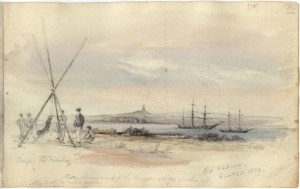Charles Darwin’s voyage on Beagle unfolds online in works by ship’s artist by Maev Kennedy.

Slinging the monkey, Port Desire sketch by Conrad Martens on Christmas Day 1833 from Sketchbook III Photograph: Cambridge University Library
From the post:
On Christmas Day 1833, Charles Darwin and the crew of HMS Beagle were larking about at Port Desire in Patagonia, under the keen gaze of the ship’s artist, Conrad Martens.
The crew were mostly young men – Darwin himself, a recent graduate from Cambridge University, was only 22 – and had been given shore leave. Martens recorded them playing a naval game called Slinging the Monkey, which looks much more fun for the observers than the main participant. It involved a man being tied by his feet from a frame, swung about and jeered by his shipmates, until he manages to hit one of them with a stick, whereupon they change places.
…
Alison Pearn, of the Darwin Correspondence Project – which is seeking to assemble every surviving letter from and to the naturalist into a digital archive – said the drawings vividly brought to life one of the most famous voyages in the world. “It’s wonderful that everyone has the chance now to flick through these sketch books, in their virtual representation at the Cambridge digital library, and to follow the journey as Martens and Darwin actually saw it unfold.”
…
It would be a further 26 years before Darwin published his theory of evolution, On the Origin of Species by Means of Natural Selection, based partly on wildlife observations he made on board the Beagle. The voyage, and many of the people he met and the places he saw can be traced in scores of tiny lightning sketches made in pencil and watercolour by Martens – although unfortunately he joined the ship too late to record the weeping and hungover sailors in their chains – which have been placed online by Cambridge University library.
Anyone playing “slinging the monkey” at your house today?
If captured today, there would be megabytes if not gigabytes of cellphone video. But cellphone video would lack the perspective of the artist that captured a much broader scene than simply the game itself.
Video would give us greater detail about the game but at the loss of the larger context. What does that say about how to interpret body camera video? Does video capture “…what really happened?”
I first saw this in a tweet by the IHR, U. of London.